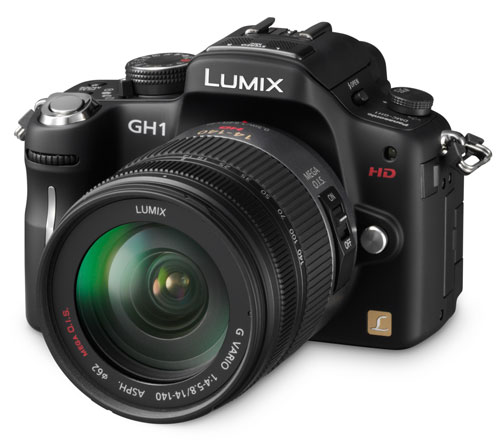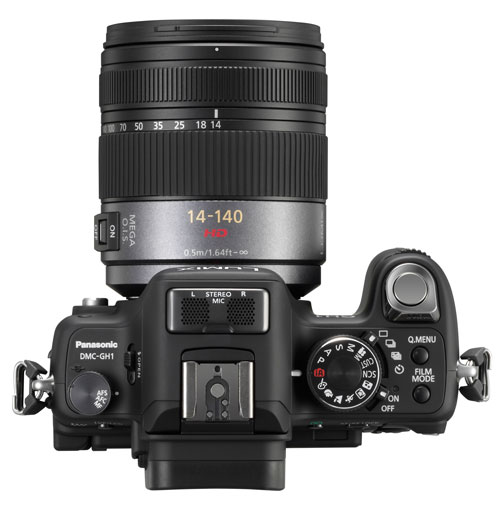PMA 2009: Panasonic GH1 & Olympus E620
by Wesley Fink on March 9, 2009 5:40 PM EST- Posted in
- Digital Camera
Panasonic GH1
When the Panasonic G1 was first announced it created a great deal of excitement for its potential to reduce interchangeable lens digital camera size by eliminating the mirror box of the Digital SLR. The actual G1 was indeed small, but not as small as many hoped. The performance and feature set, however, were outstanding, as we discussed in some detail in Digital Cameras for the Holidays. There was also the clear promise that future Micro 4/3 cameras could be even smaller and even more pocketable.
One of the most intriguing possibilities for Micro 4/3 was the promise of future video recording capabilities. Panasonic was clear that the new standard was definitely designed with video in mind and that it would be coming in the near future.
The tiny interchangeable lens Micro 4/3 cameras did not arrive at PMA 2009. Exhibitors said they were coming but it was just too soon. However, the HD video version of the G1 was announced with most of the bells and whistles promised by Panansonic.

It is true that Nikon introduced video on the D90, but it was lacking any auto-focusing capabilities at all. Canon improved the video to full HD on the $2700 5D Mark II, with incredible image quality results. However, the 5D Mark II is still limited to a contrast-detect AF system that is so slow that it can severly limit video recording capabilities.
The Panasonic GH1 featured only contrast-detect focusing, which had been dramatically improved to be as fast as competitor DSLRs traditional phase-detect AF. With that in mind it should come as no surprise that the Panasonic GH1 actually delivers very usable HD video recording with fast AF and real-time fact detection. In fact the best HD video of the interchangeable lens digital still cameras, and the first to actually deliver a video recording system on a “DSLR” without severe limitations.
The Panasonic Lumix DMC-GH1 is even bundled with a kit lens designed for video, with a super silent AF motor and continuous AF. The LUMIX G VARIO HD 14-140mm/F4.0-5.8 ASPH./MEGA O.I.S comes with the camera or it is also available as a separate purchase).

Body design is nearly unchanged from the G1 model. The changes include a stereo microphone housed on the top of the popup flash and a new movie record button on the rear panel that can be easility operated with the thumb to start and stop video recording. The rest of the exterior changes are just cosmetic, like the red "HD" under the AF assist light on the front panel. The G1 came in black, rd, and blue, while the GH1 will be available in black, red and gold body colors.
The high-definition video capabilities of the GH1 continuous autofocusing capability with the new 12.1 Live MOS sensor while videos are being recorded. Movies can be recorded at 1080i (1920 x 1080) or 720p (1280 x 720 pixels. 1080i videos are actually captured at 24 fps with progressive-scan (25fps PAL), and then converted and written in the camera as 60fps interlaced (50fps PAL). 720p is captured and written as 60 fls progressive scan (50fps PAL).
the GH1 can also offer an impressive 60 frames-per-second (NTSC; 50 frames per second for PAL). Note though that 1080i videos are actually captured at 24 fps progressive-scan (NTSC; 25fps PAL), and then converted in-camera to be written as 60fps interlaced (NTSC; 50fps PAL).
With the LUMIX G VARIO HD 14-140mm/F4.0-5.8 MEGA OIS lens keeps AF noise very low to not interfere with audio recording. In addition the GH1 can use Face Detection Intelligent Exposure, Optical Image Stabilization, and even an Intelligent Scene Selection all while recording videos.
The Panasonic GH1 specifies the same 12.1 megapixel resolution as the G1, but Panasonic says the GH1 sensor is a new design. The sensor is actually 14 megaixels in a 4/3 size (2:1 lens ratio) that allows 12.1 Megapixels in a number of aspect ratios like 4:3, 3:2, or 16:9. The extra pixels allow the same angle of view over the range of ratios available in the GH1.
The availability and price of the GH1 were not announced at PMA, but details should be announced very soon. If you have been looking for a truly capable video camera with interchangeable lenses you should check out the new GH1 when it finally ships. As a bonus it will capture 12.1 Megapixel still images over a wide ISO range.










12 Comments
View All Comments
Wesley Fink - Tuesday, March 10, 2009 - link
Our understanding is that 1920x1080 video is indeed captured at 24fps 1080p (progressive scan), but then converted in camera to 1080i at 60 fps. Given that, which would you call the capture?djc208 - Monday, March 9, 2009 - link
I had figured I'd go for an HD camcorder vice a DSLR next time I went to buy, but with cameras like the Panasonic that line is getting blurry, and it's hard to decide if I'd rather have a video camera that can take pictures, or a still camera that can take video.